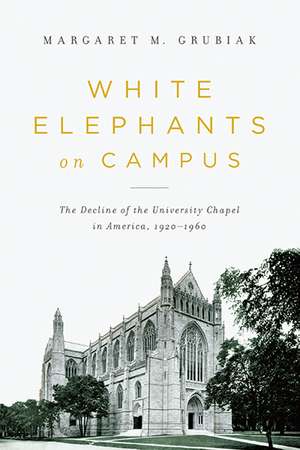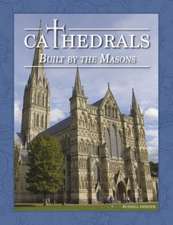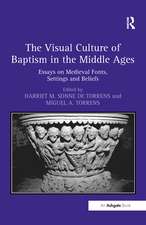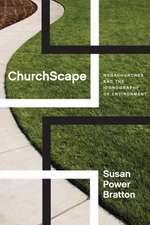White Elephants on Campus – The Decline of the University Chapel in America, 1920–1960
Autor Margaret Grubiaken Limba Engleză Paperback – 29 mar 2014
| Toate formatele și edițiile | Preț | Express |
|---|---|---|
| Paperback (1) | 223.92 lei 6-8 săpt. | |
| MR – University of Notre Dame Press – 29 mar 2014 | 223.92 lei 6-8 săpt. | |
| Hardback (1) | 585.70 lei 6-8 săpt. | |
| MR – University of Notre Dame Press – 29 sep 2022 | 585.70 lei 6-8 săpt. |
Preț: 223.92 lei
Nou
Puncte Express: 336
Preț estimativ în valută:
42.85€ • 44.57$ • 35.38£
42.85€ • 44.57$ • 35.38£
Carte tipărită la comandă
Livrare economică 14-28 aprilie
Preluare comenzi: 021 569.72.76
Specificații
ISBN-13: 9780268029876
ISBN-10: 0268029873
Pagini: 180
Dimensiuni: 152 x 229 x 10 mm
Greutate: 0.41 kg
Ediția:1st Edition
Editura: MR – University of Notre Dame Press
ISBN-10: 0268029873
Pagini: 180
Dimensiuni: 152 x 229 x 10 mm
Greutate: 0.41 kg
Ediția:1st Edition
Editura: MR – University of Notre Dame Press
Recenzii
"White Elephants on Campus is a provocative and engaging look at the university campus chapel in the twentieth century. The author skillfully combines social, educational, religious, and architectural history to illuminate a phenomenon neglected both by scholars and its intended users." —Peter W. Williams, emeritus, Miami University
"In this important new book, Margaret Grubiak tells the fascinating story of how religion declined on twentieth-century American campuses and yet, at the same time, administrators persisted in building college chapels, including some of great size and striking architectural merit. This well-written and thoroughly researched account reveals much about American architecture but even more about the larger cultural retreat from Protestantism by the nation's intellectual elites. We have long needed such a study, and Grubiak has done a masterful job in presenting it." —W. Barksdale Maynard, Princeton University
"White Elephants on Campus is an engagingly written and accessible monograph on the history of the American university chapel. Margaret Grubiak adds to the scholarship on the secularization of American higher education by exploring the material culture of the American campus. The book will appeal to architectural historians and can be used in courses on architectural history, campus planning, religion or theology, American studies, and cultural studies." —Duncan Stroik, editor of Sacred Architecture Journal
“In White Elephants on Campus, architectural historian Margaret M. Grubiak examines the changing role of religion within certain elite American universities and colleges and concludes that because these institutions’ core missions and identities are no longer religious, their magnificent chapels and other religiously informed structures have become white elephants. . . . As Grubiak notes, the massive chapels built during the fat 1920s represented university administrators’ attempts to reinforce the notion that religion was a positive and eternal force even as religion’s place in society and the academy was in transition.” —Christian Century
"When I first saw the gothic chapel at Princeton University many years ago, I was quite taken aback. It was large, beautiful inside and out with a spectacular stained glass window over the altar, and seemed surprisingly Catholic for a university that I had always taken to be professionally secular, neutral and mainly disinterested in religious matters. Margaret Grubiak's book offers a great deal of enlightenment on the unusual circumstances and controversies over chapel construction and gives intriguing thoughts on the reasons for their decline. When finished with the book, I actually wished for an extension of it into current times to see what has since been the fate of the 'white elephants.'" —America
“What can campus architecture tell us about the shifting tides of religion in American higher education? Architectural historian Margaret M. Grubiak addresses this question through five case studies. . . . Grubiak supports her discussion of these symbolically charged building projects with thorough archival work and attention to the architectural and decorative features of the buildings.” —American Historical Review
“In taking readers to various campuses, Grubiak, an associate professor of architectural history at Villanova University, places them in the midst of the debates and the decisions regarding not only chapels, but also libraries and science labs. She explains the architectural styles of various structures – explanations that might be a challenge to comprehend for those not versed in that field. But what is more important is her explanation of the significance of those structures, their locations, e.g., the Yale Divinity School being constructed nearly a mile from the campus center, and even their names, e.g., the University of Pittsburgh’s library, the Cathedral of Learning.”—TheBostonPilot.com
“The reasons for the building of these white elephants are complicated and fascinating, and Grubiak deftly explores the intersection of the rise of science with the decline of Christianity, and the social and cultural causes and effects of these changes. . . . In the end, Grubiak provides a thorough history that explains architectural shifts in the light of religious shifts in American higher education.”—History of Education Quarterly
“Grubiak has written a model micro-history that has macro implications beyond ‘the decline of the university chapel in America, 1920-1960.’ This study demonstrates how buildings reflect the relative strengths of sacred and secular in the university.” —Anglican and Episcopal History
“The reasons for the building of these white elephants are complicated and fascinating, and Grubiak deftly explores the intersection of the rise of science with the decline of Christianity, and the social and cultural causes and effects of these changes. . . . In the end, Grubiak provides a thorough history that explains architectural shifts in the light of religious shifts in American higher education.”—History of Education Quarterly
“Grubiak has written a model micro-history that has macro implications beyond ‘the decline of the university chapel in America, 1920-1960.’ This study demonstrates how buildings reflect the relative strengths of sacred and secular in the university.” —Anglican and Episcopal History
“. . . Grubiak traces the declining influence of conventional Christian religion in American higher education, particularly at large, prestigious universities. However, she does not merely rehearse that now familiar narrative; instead, drawing upon her expertise as an architectural historian, Grubiak investigates campus chapels (and some other buildings), demonstrating effectively that they were designed and erected as tangible strategies to secure a continuing, yet contemporary role for religion in university life even as scientific disciplines gained prominence. Scholars of higher education, American religion, and religious architecture, as well as those involved in campus ministry, will find the book engaging and instructive.” —Lutheran Quarterly
“This interesting book analyzes the architectural styles, the placement of the chapel on campus, the personalities behind the construction, and the reaction of student bodies to the chapel on their campuses.” —Catholic Library World
“What is the relationship between architecture and cultural, social, religious, and spiritual values? To what extent do our buildings reflect our core values and commitments? . . . Margaret M. Grubiak approaches these questions through a particular lens: religious buildings, notably chapels, on the campuses of what she identifies as ‘elite’ American universities, each of which had something of a Protestant heritage, including Harvard, Johns Hopkins, Princeton, Yale, and MIT.” —International Journal of Christianity and Education
“By presenting the history of the plans for and construction of chapel buildings on private university campuses, Margaret M. Grubiak advances the argument that colleges and universities in the United States became more secularized in the twentieth century. Especially interesting is Grubiak’s inclusion in her study of nonchapel buildings that were given religious meaning and design.” —The Catholic Historical Review
“This interesting book analyzes the architectural styles, the placement of the chapel on campus, the personalities behind the construction, and the reaction of student bodies to the chapel on their campuses.” —Catholic Library World
“What is the relationship between architecture and cultural, social, religious, and spiritual values? To what extent do our buildings reflect our core values and commitments? . . . Margaret M. Grubiak approaches these questions through a particular lens: religious buildings, notably chapels, on the campuses of what she identifies as ‘elite’ American universities, each of which had something of a Protestant heritage, including Harvard, Johns Hopkins, Princeton, Yale, and MIT.” —International Journal of Christianity and Education
“By presenting the history of the plans for and construction of chapel buildings on private university campuses, Margaret M. Grubiak advances the argument that colleges and universities in the United States became more secularized in the twentieth century. Especially interesting is Grubiak’s inclusion in her study of nonchapel buildings that were given religious meaning and design.” —The Catholic Historical Review
Notă biografică
Margaret M. Grubiak is associate professor of architectural history at Villanova University.
Descriere
In White Elephants on Campus: The Decline of the University Chapel in America, 1920–1960, Margaret M. Grubiak persuasively argues, through a careful selection of case studies, that the evolution of the architecture of new churches and chapels built on campuses reveals the shifting and declining role of religion within the mission of the modern American university. According to Grubiak, during the first half of the twentieth century, university leaders tended to view architecture as a means of retaining religion within an increasingly scientific and secular university. Initially, the construction of large-scale chapels was meant to advertise religion's continued importance to the university mission. Lavish neo-Gothic chapels at historically Protestant schools, although counter to traditional Protestant imagery, were justified as an appeal to students' emotions. New cathedral-style libraries and classroom buildings also re-imagined a place for religion on campuses no longer tied to their founding religious denominations.
Despite such attempts to reframe religion for the modern university, Grubiak shows that by the 1960s the architectural styles of new religious buildings had changed markedly. Postwar university chapels projected a less distinct image, with their small scale and intentionally nondenominational focus. By the mid-twentieth century, the prewar chapels had become "white elephants." They are beautiful, monumental buildings that nevertheless stand outside the central concerns of the modern American university. Religious campus architecture had lost its value in an era where religion no longer played a central role in the formation and education of the American student.
"White Elephants on Campus is a provocative and engaging look at the university campus chapel in the twentieth century. The author skillfully combines social, educational, religious, and architectural history to illuminate a phenomenon neglected both by scholars and its intended users." —Peter W. Williams, emeritus, Miami University
"In this important new book, Margaret Grubiak tells the fascinating story of how religion declined on twentieth-century American campuses and yet, at the same time, administrators persisted in building college chapels, including some of great size and striking architectural merit. This well-written and thoroughly researched account reveals much about American architecture but even more about the larger cultural retreat from Protestantism by the nation's intellectual elites. We have long needed such a study, and Grubiak has done a masterful job in presenting it." —W. Barksdale Maynard, Princeton University
Despite such attempts to reframe religion for the modern university, Grubiak shows that by the 1960s the architectural styles of new religious buildings had changed markedly. Postwar university chapels projected a less distinct image, with their small scale and intentionally nondenominational focus. By the mid-twentieth century, the prewar chapels had become "white elephants." They are beautiful, monumental buildings that nevertheless stand outside the central concerns of the modern American university. Religious campus architecture had lost its value in an era where religion no longer played a central role in the formation and education of the American student.
"White Elephants on Campus is a provocative and engaging look at the university campus chapel in the twentieth century. The author skillfully combines social, educational, religious, and architectural history to illuminate a phenomenon neglected both by scholars and its intended users." —Peter W. Williams, emeritus, Miami University
"In this important new book, Margaret Grubiak tells the fascinating story of how religion declined on twentieth-century American campuses and yet, at the same time, administrators persisted in building college chapels, including some of great size and striking architectural merit. This well-written and thoroughly researched account reveals much about American architecture but even more about the larger cultural retreat from Protestantism by the nation's intellectual elites. We have long needed such a study, and Grubiak has done a masterful job in presenting it." —W. Barksdale Maynard, Princeton University




